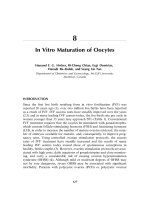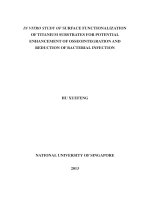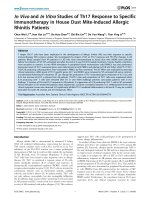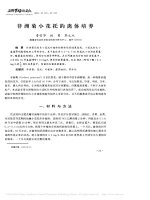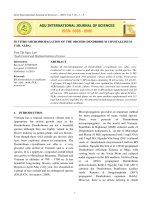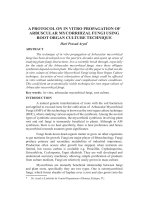In vitro efficacy of biocontrol agents against Pythium aphanidermatum (Edson) Fitz
Bạn đang xem bản rút gọn của tài liệu. Xem và tải ngay bản đầy đủ của tài liệu tại đây (370.2 KB, 6 trang )
Int.J.Curr.Microbiol.App.Sci (2020) 9(8): 2376-2381
International Journal of Current Microbiology and Applied Sciences
ISSN: 2319-7706 Volume 9 Number 8 (2020)
Journal homepage:
Original Research Article
/>
In vitro Efficacy of Biocontrol Agents against
Pythium aphanidermatum (Edson) Fitz
P. Naveena1*, V. Prasanna Kumari1, P. Anil Kumar1 and C. Sandhya Rani2
1
Department of Plant Pathology, 2Department of Entomology, Agricultural college,
Bapatla – 522 101, Andhra Pradesh, India
*Corresponding author
ABSTRACT
Keywords
Pythium
aphanidermatum,
Biocontrol agents,
Antifungal activity
Article Info
Accepted:
20 July 2020
Available Online:
10 August 2020
Present experiment was conducted to evaluate the antifungal efficacy of
different biocontrol agents against Pythium aphanidermatum. The six
isolates of Trichoderma viz., Trichoderma isolate1, Trichoderma isolate 2,
Trichoderma isolate 3, Trichoderma isolate 4, Trichoderma isolate 5 and
Trichoderma isolate 6 were studied for their antagonistic nature against P.
aphanidermatum in vitrousing dual culture method. It was observed that all
the Trichoderma isolates acted as antagonists and significantly reduced the
mycelial growth of the pathogen (3.10 to 4.6 cm) over control (9.00 cm).
Introduction
Pythiumspp. are commonly referred to as
water moulds that belongs to the kingdom
Chromista,
phylum
Oomycota,
class
oomycetes, subclass Peronosporomycetidae
and family Pythiaceae (Kirk et al., 2008).
They naturally exist in soil and water as
saprophytes and infect the hypocotyl of
seedlings where they live as parasites. Among
the Pythium spp. Pythium aphanidermatum
(Edson) Fitz. iscosmopolitan in distribution
and very common causing damping off in
nurseries which is a major constraint in
tomato production causing 62 per cent
mortality of seedlings (Ramamoorthy et al.,
2002).
The most common method to check damping
off in nursery beds is the use of fungicides,
but frequent and indiscriminate uses of
fungicides often leads to environmental
pollution and development of resistance in
pathogens (Shanmugam and Varma, 1999).
Materials and Methods
Six isolates of Trichoderma were isolated
from the rhizosphere soils of tomato
seedlings.
The antagonistic potential of the biocontrol
agents was tested against P. aphanidermatum
by using dual culture technique (Dennis and
Webster, 1971).
2376
Int.J.Curr.Microbiol.App.Sci (2020) 9(8): 2376-2381
Isolation of the pathogen
The fungus P. aphanidermatum was isolated
from the collar region of the infected plants
showing damping-off symptoms using tissue
segment method and purified by single hyphal
tip method (Rangaswami, 1958). Small
diseased tissues from infected collar region (3
mm) along with some healthy tissue were cut
with sterile scalpel. The samples were surface
sterilized with 0.1 % mercuric chloride
solution for 30 sec. The diseased samples
were subsequently washed in three changes of
sterile distilled water to eliminate mercuric
ions. The surface sterilized plant samples
were transferred onto PDA medium in Petri
dishes and incubated at 25 ± 1°C in inverted
position to avoid contamination and growth
was observed periodically.
Isolation of fungal biocontrol agents
Fungal antagonists were isolated by following
serial dilution technique (Johnson and Curl,
1977). Soil samples were collected from the
rhizosphere of tomato seedlings and were
shade dried prior to use. 1 g of soil was
suspended in 9ml of sterile water blank to
make a suspension. Serial dilutions 10-2 to 107
were made by pipetting 1ml into additional
9 ml water blanks. Finally 1 ml aliquot of
desired dilution was added to molten and
lukewarm medium and poured into sterilized
Petri plates. Plates were rotated gently on the
laminar air flow bench to get uniform
distribution of soil suspension in the medium.
Then the plates were incubated in an inverted
position at 25 ± 1ºC and observed for desired
colonies. For enumeration of fungi, 10-3
dilution of spore suspension was taken for
isolation. Isolation of fungal antagonists was
specifically done on Trichoderma selective
medium with three day old colonies of fungal
antagonists i.e., Trichoderma which were
picked up and purified by single spore
method.
All the treatments were replicated four times
and incubated at 25±10C. Observations were
recorded pertaining to colony diameter and
the per cent inhibition of the pathogen over
control was calculated by adopting the
formula as suggested by Vincent (1927).
C–T
Per cent inhibition (I %) = -------------- X 100
C
I = Per cent inhibition in mycelial growth
C = Growth of pathogen in control plates
T = Growth of pathogen in treatment plates
Dual culture technique
Twenty ml of autoclaved PDA was poured
aseptically in to 9 cm sterile Petri plates and 2
mm mycelial discs were cut from the edge of
actively growing three day old culture of the
pathogen and of the fungal antagonist with the
help of sterilized cork borer and placed at the
periphery at about 1 cm from the edge of the
Petri plate opposite to one another. Pathogen
without antagonist served as control.
Results and Discussion
In vitro efficacy of Trichoderma isolates on
P. aphanidermatum
The six isolates of Trichoderma viz.,
Trichoderma isolate 1, Trichoderma isolate 2,
Trichoderma isolate 3, Trichoderma isolate 4,
Trichoderma isolate 5 and Trichoderma
isolate6 were studied for their antagonistic
nature against P. aphanidermatum in vitro
using dual culture method.
It was observed that all the Trichoderma
isolates acted as antagonists and significantly
reduced the mycelial growth of the pathogen
(3.10 to 4.6 cm) over control (9.00 cm) (Table
1 and Plate 1) (Fig. 1-3).
2377
Int.J.Curr.Microbiol.App.Sci (2020) 9(8): 2376-2381
Among the different isolates, isolate 3 was
found significantly superior over other
isolates with the highest inhibition per cent
(65.56 %) with a minimum radial growth
(3.35 cm) and was followed by isolate 6
(61.67) and isolate 1 (60.00) which were on
par with each other. Isolate 2 was slow
growing and showed least inhibition of test
pathogen Pythium which had overgrown the
Trichoderma, though isolate 4 was fast in in
its mycelial growth but it failed to inhibit
pathogen and was overgrown by the Pythium.
Rest of the isolates had grown fast and
showed lysis at the point of interaction and
inhibited the growth of pathogen mycelium
(Fig. 3).
The present results are in accordance with
reports of Rattan et al., (2017) who reported
inhibition of Pythium spp. by T. koningii
(51.13%), T. harzianum (47.8%) andT.
longibrachiatum (35.56%), T. Viride and T.
hamatum (44.94%).
Table.1 Efficacy of fungal antagonists against P. Aphanidermatum
S.No.
1
2
3
4
5
6
7
Trichoderma as fungal
biocontrol agent
Isolate1
Isolate2
Isolate3
Isolate4
Isolate5
Isolate6
Control
SEm±
C.D. (0.05%)
CV%
*Mean Radial Growth
(cm)
3.60
4.60
3.10
3.92
3.62
3.45
9.00
0.062
0.184
2.782
Inhibition
(%)
60.00
48.89
65.56
56.39
59.72
61.67
-
*Mean of four replications
Fig.1 Lysis of pathogen Mycelium at the point of interaction; Fig.2 Microbial interactions of
Trichoderma with P. aphanidermatum
Fig.1
Fig. 2
2378
Int.J.Curr.Microbiol.App.Sci (2020) 9(8): 2376-2381
Fig.3 Inhibition in the growth of P. aphanidermatum dual cultured
with Tricoderma strains
Plate.1 In vitro efficacy of Trichoderma isolates against P. aphanidermatum by
dual cultue method
PYTHIUM
T1
T2
T3
T4
Thakur et al., (2017) also reportedfungal
inhibition by T. Harzianum (50.28%) and T.
T5
T6
hamatum (44.94%) over Pythium and
Fusarium sp. causing ginger rhizome rot. In
2379
Int.J.Curr.Microbiol.App.Sci (2020) 9(8): 2376-2381
vitro experiments conducted by Muthukumar
et al., (2011) with eight Trichoderma isolates
from chilli rhizosphere showed that TVC3
isolate recorded maximum growth inhibition
on mycelial growth of P. aphanidermatum
(88.0%) compared with control, followed by
THC1 (83.9%) and TVC5 (80.0%).
Muthukumar et al., (2010) studies also
reported highest mycelial growth inhibition of
P. Aphanidermatum with the combination of
T. viride +P. fluorescens + Zimmu leaf
extract.
Microbial interactions of Trichodermaisolate
3 also showed antagonistic with the pathogen
(Fig. 2).
Neelamegan
(2004)
also
evaluated
Trichoderma isolates viz.T. viride, T.
harzianum and Laetisaria for the antagonistic
activity against P. indicumin vitro.Among
them, T. viride was highly inhibitory to P.
indicum. Volatile andnon-volatile antibiotics
of T. viride significantly inhibited the growth
of P. indicum in vitro.
Ten strains of Trichoderma species were
screened against P. aphanidermatum by dual
culture method. Efficacy of culture filtrates
ofthe strains was also determined.
Since mycoparasitism plays importantrole in
antagonism mechanism of Trichoderma spp.,
extracellularenzymatic activity of the strains
was assayed. Among the strains tested, T.
viride 1433 was found most effective against
P. aphanidermatum (Vinit Kumar Mishra,
2010).
In conclusion, it was observed that among the
different isolates tested, isolate 3 was found
significantly superior over other isolates with
the highest inhibition per cent (65.56 %) and
with a minimum radial growth.
References
Dennis C and Webster J 1971 Antagonistic
properties
of
species-groups
of
Trichoderma.
I.
Production
of
nonvolatile antibiotics. Transactions of
the British Mycological Society, 57: 2539.
Johnson LF and Curl EA 1977 Methods for
research on the ecology of soil borne
plant pathogens. Burgess Publishing
Company Minneapolis, Pp. 27-35.
Kirk P, Cannon PF, Minter D W and Stalpers
JA 2008 Ainsworth & Bisby’s
Dictionary of the Fungi. 10th edition.
CAB International, Wallingford, UK.
Muthukumar A Eswaran A and Sangeeta G
2010Occurance,
virulence
and
pathogenicity of species of Pythium
inciting damping-off disease in chilli.
Journal of Mycology and Plant
Pathology, 40(1): 67-71.
Muthukumar
A,
Eswaran
A
and
Sanjeevkumar K 2011 Exploitation of
Trichoderma Species on the growth of
Pythium
aphanidermatum.Brazilian
Journal of Microbiology, 42: 15981607.
Neelamegam R 2004 Evaluation of fungal
antagonists to control damping-off of
tomato Lycopersicon esculentum Mill.
caused by Pythium ultimum. Journal of
Biological Control, 18:97–102.
Ramamoorthy V, Raghuchander T and
Samiyappan R 2002 Enhancing resistant
of tomato and hot pepper to Pythium
disease by seed treatment with
Fluorescent pseudomonads. European
Journal of Plant Pathology, 108: 429441.
Rangaswami G 1958 An agar blocks
technique
for
isolating
soil
microorganisms with special reference
to Pythiaceous fungi. Science Culture,
24: 85.
Rattan V, Mishra A, Singh R, Tomar A,
2380
Int.J.Curr.Microbiol.App.Sci (2020) 9(8): 2376-2381
Trivedi S and Dixit S 2017 In vitro
evaluation of chemical fungicides and
bioagents
against
Pythium
aphanidermatum. Journal of Natural
Resource andDevelopment, 12 (1): 1114.
Shanmugam V and Varma AS 1999 Effect of
native antagonists against Pythium
aphanidermatum, the causal organism
of rhizome rot of ginger. Journal of
Mycology and Plant Pathology, 29 (3):
375-379.
Thakur A, Thakur N and Dohroo N P 2017
Rhizome rot of ginger-management
through
non-chemical
approach.
International
Journal
of
Plant
Protection, 10 (1): 140-145.
Vincent J M 1927 Distribution of fungal
hyphae in the presence of certain
inhibitors. Nature, 159: 850.
Vinit Kumar Mishra 2010 In Vitro
Antagonism of Trichoderma Species
against Pythium
aphanidermatum.
Journal of Phytology, 2(9): 28-35.
How to cite this article:
Naveena, P., V. Prasanna Kumari, P. Anil Kumar and Sandhya Rani, C. 2020. In vitro Efficacy
of
Biocontrol
Agents
against
Pythium
aphanidermatum
(Edson)
Fitz.
Int.J.Curr.Microbiol.App.Sci. 9(08): 2376-2381. doi: />
2381
